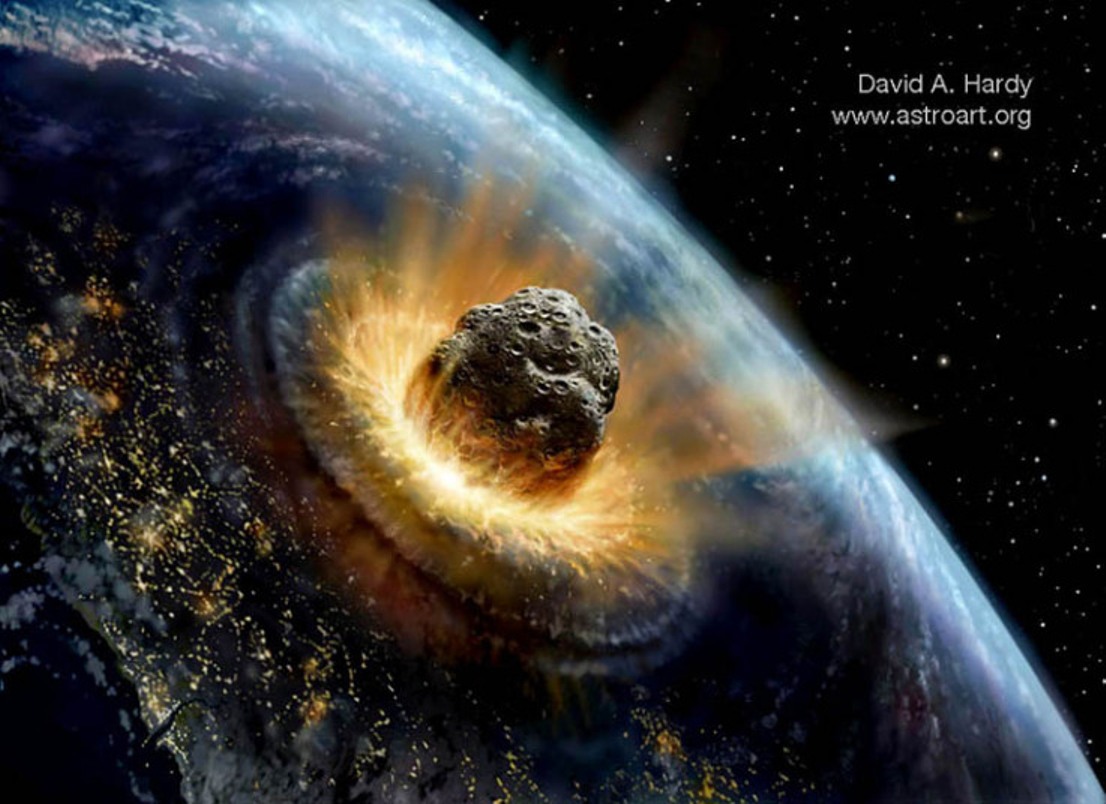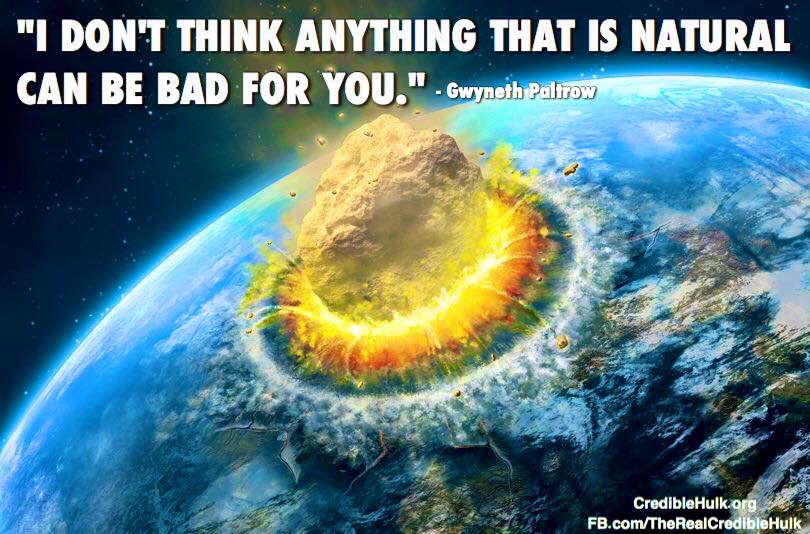The Cretaceous-Tertiary (K-T boundary) extinction ~66 million years ago is perhaps the most famous extinction event in Earth’s history. It featured a massive asteroid impact which led to the extinction of an estimated 76% of all fossilizable species, and marked the end of the ~170 million+ year reign of the dinosaurs (Pope 1998). Initially regarded as a radical proposition, this is the Alvarez hypothesis, after Luis Alvarez, the lead scientist of the team that discovered the first of multiple lines of smoking gun evidence for the impact of an asteroid ~10 km across under Chicxulub on the coast of the Yucatan Peninsula right around the time of the K-T boundary (Alvarez 1979, Smit 1981, Smit 1980, Bohor 1984, Bohor 1987, Bourgeois 1988 & Hildebrand 1991).
In addition to the famous K-T extinction, which is also sometimes referred to in the literature as the Cretaceous-Paleogene (or K-Pg boundary) extinction, I also mentioned that one or more meteoroid impact may have been one of several contributing factors of Earth’s worst mass extinction event of all time: the Permian extinction. So, such impacts may have affected life on Earth on more than one occasion, but in precisely what ways can such impact events affect the climate? First of all, let’s clarify the difference between an asteroid, comet, bolide, meteoroid or meteorite:
The degree to which an asteroid impact affects the climate depends on its size and mass. It’s estimated that an impact which releases a million megatons of energy (representing an asteroid roughly 2 km in diameter) would produce about 10^16 kg of ejecta, which is approximately on par with an M9 Super Volcano (Morrison 2006). That’s near the upper limit of what is considered possible. In terms of energy, such an impact would also be on par with an earthquake of magnitude 10, which is beyond the range considered to be possible (Morrison 2006). This would likely also be accompanied by a subsequent tsunami as well as wild fires due to thermal radiation. Insofar as climatological effects, an impact in this range would have significant global effects on the ozone (ostensibly destroying it), and would produce enough stratospheric dust and sulfates to induce global cooling (Toon 1997, & Pierazzo 1998).
The Chicxlub K-T boundary event in particular may have also indirectly triggered global warming effects by releasing large amounts of carbon monoxide (CO) (Kawarigi 2009). Although only a weak greenhouse gas, CO tends to react with hydroxyl (OH) radicals in the atmosphere. This reduces their abundance. The OH radicals normally help limit the lifetime of stronger greenhouse gases like methane, so the idea is that CO released by the K-T boundary impact event may have led to global warming by reducing atmospheric OH radical concentrations, thus increasing greenhouse gases by extending their lifetime.
So as you can see, some of these effects can sometimes work in opposition to one another, and it’s not always obvious which effects will “win out” in either the short term or the long term for a particular impact. In this example, the resultant warming effects may have potentially been compounded by the 0.8 million years of Deccan Traps basalt eruptions overlapping the K-T boundary, and were ultimately more than offset by the acute sulfate aerosol cooling effects (Keller 2008, & Pope 1997).
The impact event is believed to have caused so-called Impact Winter effects for a few decades; these consisted of darkness and cooling from ash, debris and sulfate aerosols, which thus inhibited photosynthesis for up to a year (Vellekoop 2014, Schulte 2010, Ohno 2014, Pope 1998). It also likely led to acid rain and ocean acidification (Schulte 2010, & Ohno 2014) There is evidence of a relatively fast post-climatic recovery (Pierazzo 2003), but insofar as 76% of fossilizable species on Earth were concerned, the damage was already done.
I should mention that this is just the most well-known scientific hypothesis for the primary cause of the K – T boundary extinction. There are alternative hypotheses regarding the causes of the extinction itself, such as the aforementioned Deccan Traps (Keller 2008), the Multiple Impact Hypothesis, the Maastrichtian Sea Regression hypothesis (li 1998), and research which proposes combinations of two or more of these factors (Peterson 2016). But the fact that the Chicxlub Impact occurred is not a matter of serious contention. The evidence for it is about as close to a proverbial smoking gun as one could expect to get in science. These alternatives don’t contradict that. Rather, they merely posit that the impact was not the sole and/or primary cause of the mass extinction, which is not germane to my focus here, which has been on using the Chicxlub event as an example of how such impacts can affect Earth’s climate.
That said, it should go without saying that the current climate change we are experiencing is not attributable to meteorite and asteroid impacts. Their climatic effects are proportional to their magnitude, but we track them, and the big ones are far too conspicuous to go unnoticed.
Oh, and in case the prospect of a massive impact has anyone alarmed, just realize that potential impact threats are closely monitored, so we’d most-likely know well ahead of time (at least for the larger ones). For smaller ones, which might not be detected until weeks or days before impact, there is also ATLAS: the Asteroid Terrestrial – impact Last Alert System. Of course knowing in advance is only as useful as our best impact avoidance and/or evacuation protocols. But hey! The really big impacts are even less frequent than Super Volcanoes. There are plenty of more probable calamities to worry about than having one’s home city vaporized by an asteroid impact.
Besides, mass extinctions are 100% natural! And nobody ever said that the Universe was nothing but sunshine and rainbows, right?
Okay, so maybe some people have alluded to that, but oh well. She was wrong.
- Credible hulk
References:
Alvarez, L. W., Alvarez, W., Asaro, F., & Michel, H. V. (1979). Extraterrestrial cause for the Cretaceous-Tertiary extinction: Experiment and theory.
Bohor, B. F., Foord, E. E., Modreski, P. J., & Triplehorn, D. M. (1984). Mineralogic evidence for an impact event at the Cretaceous-Tertiary boundary.Science, 224(4651), 867-869.
Bohor, B. F., Modreski, P. J., & Foord, E. E. (1987). Shocked quartz in the Cretaceous-Tertiary boundary clays: Evidence for a global distribution.Science, 236(4802), 705-709.
Kawaragi, K., Sekine, Y., Kadono, T., Sugita, S., Ohno, S., Ishibashi, K., … & Ikeda, S. (2009). Direct measurements of chemical composition of shock-induced gases from calcite: an intense global warming after the Chicxulub impact due to the indirect greenhouse effect of carbon monoxide. Earth and Planetary Science Letters, 282(1), 56-64.
Bourgeois, J., WIBERG, P., HANSEN, T., & KAUFFMAN, E. (1988). A tsunami deposit at the Cretaceous-Tertiary boundary in Texas. Science,241(4865), 567-570.
Keller, G., Adatte, T., Gardin, S., Bartolini, A., & Bajpai, S. (2008). Main Deccan volcanism phase ends near the K–T boundary: evidence from the Krishna–Godavari Basin, SE India. Earth and Planetary Science Letters,268(3), 293-311.
Li, L., & Keller, G. (1998). Abrupt deep-sea warming at the end of the Cretaceous. Geology, 26(11), 995-998.
Morrison, D. (2006). Asteroid and comet impacts: the ultimate environmental catastrophe. Philosophical Transactions of the Royal Society of London A: Mathematical, Physical and Engineering Sciences, 364(1845), 2041-2054.
Ohno, S., Kadono, T., Kurosawa, K., Hamura, T., Sakaiya, T., Shigemori, K., … & Matsui, T. (2014). Production of sulphate-rich vapour during the Chicxulub impact and implications for ocean acidification. Nature Geoscience, 7(4), 279-282.
Petersen, S. V., Dutton, A., & Lohmann, K. C. (2016). End-Cretaceous extinction in Antarctica linked to both Deccan volcanism and meteorite impact via climate change. Nature Communications, 7.
Pierazzo, E., Kring, D. A., & Melosh, H. J. (1998). Hydrocode simulation of the Chicxulub impact event and the production of climatically active gases.Journal of Geophysical Research: Planets, 103(E12), 28607-28625.
Pierazzo, E., Hahmann, A. N., & Sloan, L. C. (2003). Chicxulub and climate: radiative perturbations of impact-produced S-bearing gases. Astrobiology,3(1), 99-118.
Pope, K. O., Baines, K. H., Ocampo, A. C., & Ivanov, B. A. (1997). Energy, volatile production, and climatic effects of the Chicxulub Cretaceous/Tertiary impact. Journal of Geophysical Research: Planets, 102(E9), 21645-21664.
Pope, K. O., D’Hondt, S. L., & Marshall, C. R. (1998). Meteorite impact and the mass extinction of species at the Cretaceous/Tertiary boundary.Proceedings of the National Academy of Sciences, 95(19), 11028-11029.
Schulte, P., Alegret, L., Arenillas, I., Arz, J. A., Barton, P. J., Bown, P. R., … & Collins, G. S. (2010). The Chicxulub asteroid impact and mass extinction at the Cretaceous-Paleogene boundary. Science, 327(5970), 1214-1218.
Smit, J., & Hertogen, J. (1980). An extraterrestrial event at the Cretaceous–Tertiary boundary. Nature, 285(5762), 198-200.
Smit, J., & Klaver, G. (1981). Sanidine spherules at the Cretaceous–Tertiary boundary indicate a large impact event. Nature, 292(5818), 47-49.
Toon, O. B., Zahnle, K., Morrison, D., Turco, R. P., & Covey, C. (1997). Environmental perturbations caused by the impacts of asteroids and comets.Reviews of Geophysics, 35(1), 41-78.
Vellekoop, J., Sluijs, A., Smit, J., Schouten, S., Weijers, J. W., Damsté, J. S. S., & Brinkhuis, H. (2014). Rapid short-term cooling following the Chicxulub impact at the Cretaceous–Paleogene boundary. Proceedings of the National Academy of Sciences, 111(21), 7537-7541.



3 Comments
The Solar Dynamo: The Physical Basis of the Solar Cycle and the Sun’s Magnetic Field – The Credible Hulk · January 12, 2017 at 10:20 am
[…] The Ultimate Environmental Cataclysm: Asteroid and Comet Impacts and their Effects on Climate […]
Mean Field Theory and Solar Dynamo Modeling – The Credible Hulk · January 16, 2017 at 12:39 pm
[…] The Ultimate Environmental Cataclysm: Asteroid and Comet Impacts and their Effects on Climate […]
No, Solar Variations Can’t Account for the Current Global Warming Trend. Here’s Why: – The Credible Hulk · January 17, 2017 at 9:17 am
[…] The Ultimate Environmental Cataclysm: Asteroid and Comet Impacts and their Effects on Climate […]
Comments are closed.